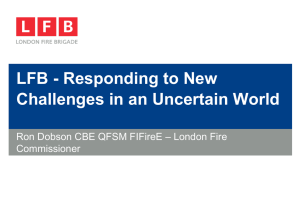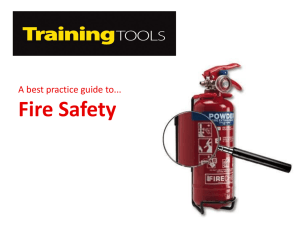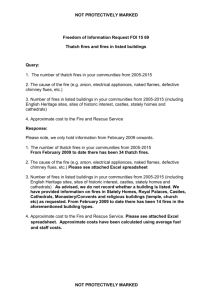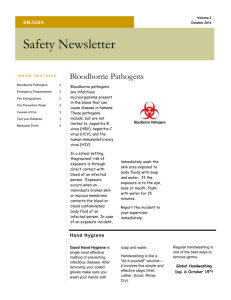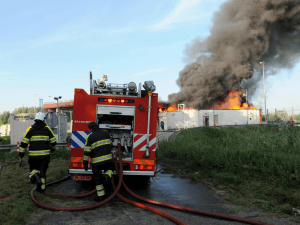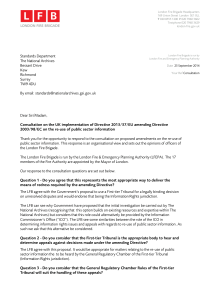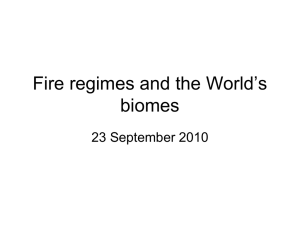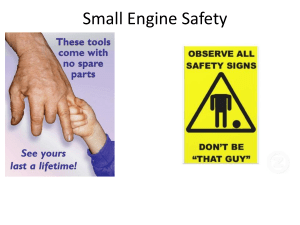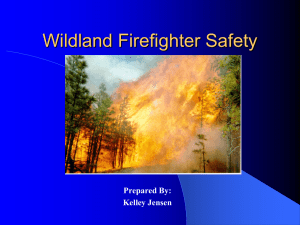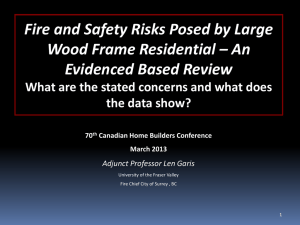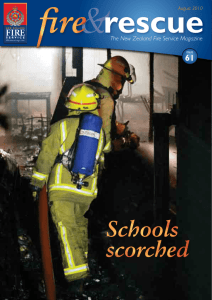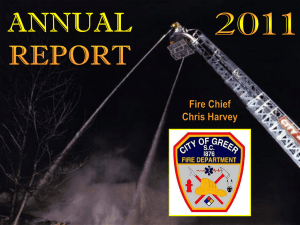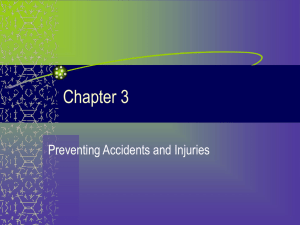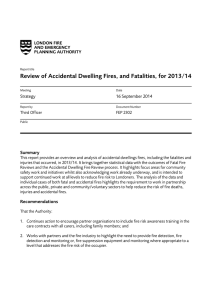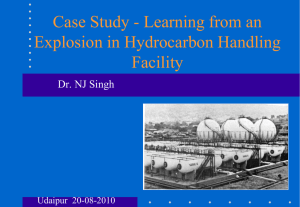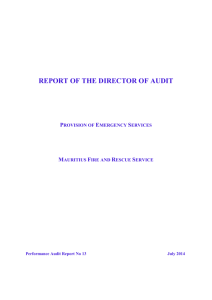LFB Presentation 2013
advertisement
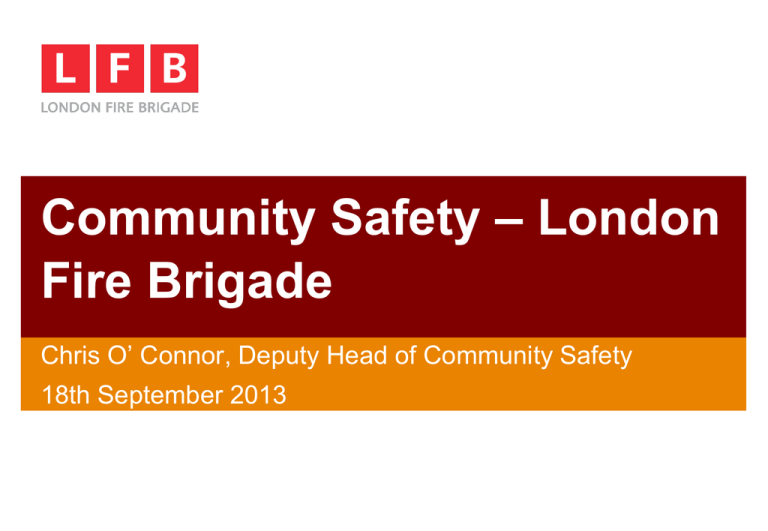
Community Safety – London Fire Brigade Chris O’ Connor, Deputy Head of Community Safety 18th September 2013 Our vision: We want to make London a safer city and our vision is to be a world class fire and rescue service for London, Londoners and visitors. Our ethos: •London’s fire and rescue service is the busiest in the country and one of the largest firefighting and rescue organisations in the world • We provide services across the whole of the Greater London area, serving 8.2 million residents as well as those who work in or visit the city. •Compared to ten years ago, the Brigade attends half as many fires and almost a third fewer incidents overall. But there is always more to be done. . Our strategy: •The Authorities responsibilities are laid out within the new London Safety Plan 5. This brings together in one document both the Corporate plan and Integrated Risk Management Action Plan and sets out our targets for the next three years. •This policy states that we aim to reduce accidental and deliberate fires in London, where they are targeted at homes, vehicles, rubbish, open land. •We will achieve this through prevention activities that focus on informing and educating people in how to reduce the risk of fire and emergencies. Our people: •Nearly 7,000 staff work for the Brigade 5,800 operational firefighters,100 Brigade Control staff dealing with 999 emergency calls and a range of nonoperational staff and additional volunteers working behind the scenes to deliver support services such as getting fire safety messages across. •People are our most vital resource in achieving our objectives. Our 6 aims are: Aim 1 - Prevention - Engaging with London’s communities to inform and educate people in how to reduce the risk of fires and other emergencies. Aim 2 – Protection - Influencing and regulating the built environment to protect people, property and the environment from harm. Aim 3 – Response - Planning and preparing for emergencies that may happen and making a high quality, effective and resilient response to them. Aim 4 – Resources - Managing risk by using our resources flexibly, efficiently and effectively, continuously improving the way we use public money. Aim 5 – People - Working together to deliver high quality services and to create a safe and positive environment for everyone in the organisation. Aim 6 – Principles - Operating in accordance with our values and ensuring that safety, sustainability, partnership and diversity run through all our activities. Aim 1 – Prevention LSP 5 (2013/14 action plan) Strategic Objective 1.1 To reduce fires & the impact they have: • Evaluate our Home Fire Safety Visits • Address unsuitable sleeping accommodation • Preventing most common fires in the homes • Reducing deliberate fires • Evaluate volunteers pilot scheme • Utilise social media Aim 1 – Prevention LSP 5 (2013/14 action plan) Strategic Objective 1.2 To target people most at risk: • Recognise, respond to and record instances of hoarding • Work with a range of local partners • Ensure people living in residential care are as safe as possible • Review our response to telecare emergency calls • Review our youth schemes to ensure they are effective • Deliver at least 60 LIFE courses during 2013/14 Reduction in incidents Primary fires attended 1970 49,314 1975 50,531 2010 13,510 2011 12,896 Fire fatalities 1975 177 1980 196 2010 60 2011 56 Community Safety - Structures • Community Safety is the term given to the Authority’s responsibility for making people safer in their homes and communities, as outlined by the Fire & Rescue Service Act 2004. • The Department of Communities and Local Government (DCLG) estimate the cost of a domestic fire in London to be £48,092 . • Prevention integral to all roles • Borough Commanders • Four Area Community Safety Teams • Central Community Safety Department Commitment to Community Safety current worksteams: • Effectiveness of Home Fire Safety Visits • Fatal fires – collation of data, reviews with Deputy Commissioner • Arson reduction • Domestic sprinklers • Hoarding • Unsuitable sleeping accommodation – Beds in Sheds • Telecare systems and partnership with social care • Safeguarding and serious outstanding risk • Road traffic Collision reduction • Accidental Dwelling Fires (ADFs) • Children and youth engagement programmes Home Fire Safety Visits •A home fire safety visit, where firefighters and support staff visit homes to provide fire safety advice and fit free smoke alarms, is our main tool to improve fire safety in the home. • But a smoke alarm cannot prevent a fire – it can only alert the occupant that a fire may have started. • The best way of reducing the potential for fires to occur is to change the behaviour of residents and we will continue to improve fire safety awareness. Youth Engagement – Local Intervention Fire Education (LIFE) • Aim – Change behaviour of young people • A five day course aimed at 14-17 year olds • Referred through Youth Offending Teams, Pupil Referral Units, Schools etc. • 60 courses per year – 15 young people per course • Delivered over 600 courses to around 6000 young people so far • Delivered at selected fire stations and inside Feltham Young Offenders Institute Youth Engagement - Community Fire Cadets (CFCs) • Aim – To develop 16 young people per course and enable them to achieve a BTEC qualification • 12 Month programme aimed at 14 – 18 year olds • Delivered at selected fire stations 1 night per week • Referrals through schools, local authorities and other youth engagement programmes • 2 courses running currently – Bexley & Havering • Next courses start in Sept 2013 • Haringey, Barking & Dagenham, Waltham Forest & Redbridge • Future courses – April 2014 • Newham, Tower Hamlets and Hackney Youth Engagement – Juvenile Firesetters Intervention Scheme (JFIS) • Aim –Change behaviour to prevent future fire setting • Works with young people up to the age of 18 years • Referrals received from families, partner agencies, LFB staff etc. • JFIS caseworkers deliver one to one sessions either in the home or a “clinic” environment in HQ • Success is – “approx. 6 months without fire setting after intervention” • Over 3,000 referrals • Running for over 10 years Education programme •Aim – To offer visits to Year 8 in every “very high priority” secondary schools annually •Aim – To deliver to Years 2 & 5 in every “very high & high priority” primary schools annually •To also deliver to medium and low schools dependant on demand •Key messages; Prevention, Detection & Escape, Consequences of Arson, Dangers of Hoax Calls •Approx. 950 schools visited per year •Approx. 1.3 million pupils have been seen since 2001 Community Safety challenges • Lots of change at local authority level (staff, budgets and priorities) • Changes in partner structures and governance (Local Strategic Partnerships, Primary Care Trusts) • Reduction in external funding so more competition • Changes in bidding processes • A need for greater evidence and evaluation of what we do • Referral processes • Being clear of our role and position • Meeting the needs of all of London’s diverse communities • Big expectations, more for less • Lots to do How can we address these challenges? • Partnership working (representation on strategic boards) • Involvement in a wider range of initiatives • Being innovative and changing how we do things (Troubled Families Programme and Health and Well-Being Boards) • Evaluation processes are mainstreamed into all our work – challenging ourselves • Looking at new delivery models • Communications and marketing (Social Media) • Understanding and implementing best practice Case Study - Who best to identify those at high risk? • LFB - repeat callers • LFB – priority postcodes • Identified through LFB Home Fire Safety Visit • Identified through other LFB involvement • Identified by partners Who is a high risk ? • Previous history of fires • Lives alone • Has a disability • Lives in social housing • Over 60 years of age • Single parent (with child under 15) • Smoker • Drink / drug dependant • Daily domiciliary care provision What can be done – a partnership approach? • HFSV – fire safety advice • Arson-proof letter boxes • Fire retardant bedding & other materials • Referral to other agencies – two way • Shared funding and priorities • Improved interaction on safeguarding boards • Domestic sprinklers / misting systems Sprinklers have been proven to reduce the impact of fire www.london-fire.gov.uk Questions ?


